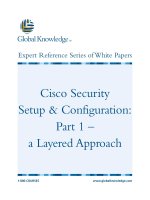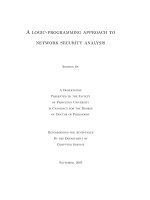Material elaborat dupa: CISCO Security Curriculum potx
Bạn đang xem bản rút gọn của tài liệu. Xem và tải ngay bản đầy đủ của tài liệu tại đây (114.01 KB, 41 trang )
11/2/2009 Vasile DADARLAT, Retele de
calculatoare, An I Master
1
Network Security
Network Security Hierarchy
Material elaborat dupa:
CISCO Security Curriculum
Kenny Paterson’s Lectures for:
M.Sc. in Information Security, Royal Holloway, University of London
11/2/2009 Vasile DADARLAT, Retele de
calculatoare, An I Master
2
CINS/F1
-
01
Objectives of Lecture
• Understand why security should be a
fundamental consideration when designing and
operating networks.
• Examine the primary enabling threats and
fundamental threats to security for networks.
• Introduce security services and mechanisms,
and show how they can be used to counter
threats.
• Study the provision of security services at
different network layers in standard ISO7498-2.
11/2/2009 Vasile DADARLAT, Retele de
calculatoare, An I Master
3
Why Network Security?
• Organisations and individuals are increasingly reliant on
networks of all kinds for day-to-day operations:
– e-mail used in preference to letter, fax, telephone for
many routine communications.
– B2B and C2B e-commerce still growing rapidly.
– the Internet is a vast repository of information of all
kinds: competitors and their prices, stock markets,
cheap flights,….
– increased reliance on networks for supply chains of all
kinds: from supermarkets to aircraft components.
– utility companies control plant, banks move money,
governments talk to citizens over networks.
– growth of mobile telephony for voice and data.
11/2/2009 Vasile DADARLAT, Retele de
calculatoare, An I Master
4
Why Network Security?
• Networks are becoming increasingly inter-connected and their
security consequently more complex:
– if I send sensitive data over my internal network, then who
else can see it or even alter it? My employees? My
competitors?
– can a hacker who gets into my internal network then get
access to other resources (computer accounts, stored
data)? Can he use my network as a stepping-off point for
further attacks? I am then liable?
– a compelling Internet presence is essential for my company,
but if someone can see my website, can they alter it too?
– how can consumers trust that a given website is that of a
reputable company and not one who will miss-use their
credit card details?
11/2/2009 Vasile DADARLAT, Retele de
calculatoare, An I Master
5
Why Network Security?
• Safeguarding the confidentiality, integrity and availability of data carried
on these various networks is therefore essential.
• Authenticity and accountability are often also important: who did what
and when?
• It’s not only about security of Internet-connected systems.
– Insider threats are often more potent than threats originating on the
Internet.
• It’s not only about TCP/IP networks
– Many networks use special-purpose protocols and architectures
– However TCP/IP dominates in LANs and the Internet.
Non secure wireless access, need for speed versus secure
connections (secure software operates at moderate speed), IT staff
shortage (more outsourcing solutions for security management)
are challenges for security
11/2/2009 Vasile DADARLAT, Retele de
calculatoare, An I Master
6
Accessing a corporate network
Open Access: permit everything that is not explicitly denied
-Easy to implement, only basic security capabilities (passwords, server
security)
- protected assets are minimal, user are trusted, threats are minimal
- isolated LANs are possible examples
Restrictive Access - Combination of restrictions and specific permissions
- configuration of specific hardware and software for security: firewalls,
VPNs, IDS (Intrusion Detection System), identity servers
-LANs connected to Internet and public WANs are examples
Closed Access - that which is not explicitly permitted is denied
-All available security measures, plus extra effort for more costly H+S
solutions
-Network administrators are accountable for problems
11/2/2009 Vasile DADARLAT, Retele de
calculatoare, An I Master
7
Security Policies for Networks
Standards for security
1. ISO/IEC 17799, Information technology – Code of practice for
information security management
- common basis and practical guideline for developing organizational
security standards and effective security management practices
ISO/IEC 17799 is made up of the following eleven sections:
Security policy
Organization of information security
Asset management
Human resources security
Physical and environmental security
Communications and operations management
Access control
Information systems acquisition, development and maintenance
Information security incident management
Business continuity management
Compliance
11/2/2009 Vasile DADARLAT, Retele de
calculatoare, An I Master
8
Security Policies for Networks
2. ISO7498-2
– a companion document to ISO7498-1 (the seven layer model),
– provides a useful overview of the security issues pertinent to networks
– equips us with a handy set of definitions to fix our terminology
Organizations for the Internet and IT security
CERT – Computer Emergency Readiness Team – reporting center for
Internet security
SANS Institute – SysAdmin, Audit, Network, Security – documents
with aspects of information security
(ISC)
2
– International Information System Security Certification
Consortium – collection of best practices for information security and
certification of conformance (System Security Certified Practitioner,
Certified Information Systems Security Professional)
Common Criteria – IT security evaluation, based on security levels
(Evaluation Assurance Level 4 – highest)
11/2/2009 Vasile DADARLAT, Retele de
calculatoare, An I Master
9
Security Policies for Networks
• In a secure system, the rules governing security
behavior should be made explicit in the form of an
Information Security Policy.
• Security policy: ‘the set of criteria for the provision of
security services’
– essentially, a set of rules
– may be very high level or quite detailed
• Security domain: the scope of application of a security
policy
– where, to what information and to whom the policy
applies.
11/2/2009 Vasile DADARLAT, Retele de
calculatoare, An I Master
10
Security Policies for Networks
• A network security policy should interpret the overall
Information Security Policy in the context of the
networked environment:
– Defines what is the responsibility of the network and what is not.
– Describes what security is to be available from the network.
– Describes rules for using the network.
– Describes who is responsible for the management and security
of the network.
11/2/2009 Vasile DADARLAT, Retele de
calculatoare, An I Master
11
Generic Security Policy
• A generic authorization policy (from ISO 7498-2):
‘Information may not be given to, accessed by, nor
permitted to be inferred by, nor may any resource be
used by, those not appropriately authorized.’
• Possible basis for more detailed policy: needs lots of
refinement to produce final document:
– What information?
– What resources?
– Who is authorized and for what?
– What about availability?
11/2/2009 Vasile DADARLAT, Retele de
calculatoare, An I Master
12
The Security Life-Cycle
• A generic model for the security life-cycle, including
network security issues, is as follows:
– define security policy,
– analyze security threats (according to policy) and
associated risks, given existing safeguards,
– define security services to meet/reduce threats, in
order to bring risks down to acceptable levels,
– define security mechanisms to provide services,
– provide on-going management of security.
11/2/2009 Vasile DADARLAT, Retele de
calculatoare, An I Master
13
Security Threats for Networks
• A threat is:
– a person, thing, event or idea which poses some
danger to an asset (in terms of confidentiality,
integrity, availability or legitimate use).
– a possible means by which a security policy may be
breached.
• An attack is a realization of a threat.
• Safeguards are measures (e.g. controls, procedures) to
protect against threats.
• Vulnerabilities are weaknesses in safeguards.
11/2/2009 Vasile DADARLAT, Retele de
calculatoare, An I Master
14
Risk
• Risk is a measure of the cost of a vulnerability (taking
into account probability of a successful attack).
• Risk analysis determines whether expenditure on new or
better safeguards is warranted.
• Risk analysis can be quantitative or qualitative.
11/2/2009 Vasile DADARLAT, Retele de
calculatoare, An I Master
15
Threats
Threats can be classified as:
• deliberate (e.g. hacker penetration);
• accidental (e.g. a sensitive file being sent to the wrong
address).
Deliberate threats can be further sub-divided:
• passive (e.g. monitoring, wire-tapping);
• active (e.g. changing the value of a financial transaction).
In general passive threats are easier to realize than
active ones.
11/2/2009 Vasile DADARLAT, Retele de
calculatoare, An I Master
16
Fundamental Threats
• Four fundamental threats (matching four ‘standard’
security goals: confidentiality, integrity, availability,
legitimate use):
– Information leakage,
– Integrity violation,
– Denial of service,
– Illegitimate use.
(There are other ways to classify threats)
11/2/2009 Vasile DADARLAT, Retele de
calculatoare, An I Master
17
Primary Enabling Threats
Realization of any of these primary enabling threats can lead directly to a
realization of a fundamental threat:
• Masquerade, where an entity pretends to be a different entity,
• Bypassing controls, where an attacker exploits system flaws or
security weaknesses, in order to acquire unauthorized rights
• Authorized violation, where an entity authorized to use a system for
one purpose uses it for another, unauthorized purpose.
• Trojan horse, where software contains an invisible part which, when
executed, compromises the security of the system,
• Trapdoor, which is a feature built into a system such that the
provision of specific input data allows the security policy to be
violated.
First three are penetration threats, last two are planting threats.
11/2/2009 Vasile DADARLAT, Retele de
calculatoare, An I Master
18
Network Security Requirements & Problems
Network Security Requirements & Problems
Network Security
Network Security – protect data during transmissions & guarantee that data
transmissions are authentic
Security Requirements
Security Requirements
Confidentiality
Confidentiality – data accessed & read only by authorized parties
Integrity
Integrity – data modification by authorized parties
Availability
Availability – data available to authorized parties
Network Security Problems
Network Security Problems (what to allow for):
Secrecy
Secrecy
Keeping information private (out of unauthorized parties)
Authentication
Authentication
Proving one’s identity, before revealing info
11/2/2009 Vasile DADARLAT, Retele de
calculatoare, An I Master
19
Non
Non
-
-
repudiation
repudiation
Showing (proving) that a message was sent; use of signatures
Integrity
Integrity
Showing that a message wasn’t modified
Attacks on Network Security
Passive Attacks
Passive Attacks
(
(
Reconnaissance attacks)
Reconnaissance attacks)
Nature of: eavesdropping (monitoring) on transmissions
Goal: to obtain information that is being transmitted:
-
-
information
information
gathering
gathering: identify usernames, passwords, or … credit card numbers
/sensitive personal information
-
-
information theft
information theft (steal credit card numbers /sensitive personal information, crack a
password file )
Tools Used to Perform Eavesdropping
- Network or protocol analyzers
-Packet capturing utilities on networked computers
-
-
use of
use of
nslookup
nslookup
and
and
whois
whois
utilities
utilities , ping command
11/2/2009 Vasile DADARLAT, Retele de
calculatoare, An I Master
20
Two types of passive attacks:
-
-
Release of message contents
Release of message contents
Outsider learns content of transmission
-
-
Traffic analysis
Traffic analysis
By monitoring frequency and length of messages, even encrypted, nature
of communication may be guessed
Passive attacks: Difficult to detect, because attacks don’t alter data; can be
prevented, rather than detected; use of
encryption, switched networks, no use of
encryption, switched networks, no use of
protocols susceptible to eavesdropping
protocols susceptible to eavesdropping
Example of action: A malicious intruder typically ping sweeps th
Example of action: A malicious intruder typically ping sweeps th
e target network
e target network
to determine which IP addresses are alive . After this, the intr
to determine which IP addresses are alive . After this, the intr
uder uses a port
uder uses a port
scanner to determine what network services or ports are active o
scanner to determine what network services or ports are active o
n the live IP
n the live IP
addresses . From this information, the intruder queries the port
addresses . From this information, the intruder queries the port
s to determine the
s to determine the
application type and version, as well as the type and version of
application type and version, as well as the type and version of
operating system
operating system
running on the target host. Based on this information, the intru
running on the target host. Based on this information, the intru
der can determine
der can determine
if a possible vulnerability exists that can be
if a possible vulnerability exists that can be
exploited.
exploited.
11/2/2009 Vasile DADARLAT, Retele de
calculatoare, An I Master
21
Active Attacks
Active Attacks
Involve some data stream modification, or creation of a false stream
Masquerade
Masquerade
Pretending to be a different entity (manipulate TCP/IP packets by IP spoofing,
falsifying the source IP address)
Replay
Replay
Capture of data unit and retransmission for an unauthorized effect
Modification of messages
Modification of messages
Some portion of a legitimate message is altered
Denial of service
Denial of service
Prevents or inhibits normal use of communications facilities
Easy to detect: detection may lead to a deterrent effect (helps prevention)
Hard to prevent (requires all time physical protection)
Use of
authentication
authentication
11/2/2009 Vasile DADARLAT, Retele de
calculatoare, An I Master
22
Security Services and Mechanisms
• A security threat is a possible means by which a security
policy may be breached (e.g. loss of integrity or
confidentiality).
• A security service is a measure which can be put in
place to address a threat (e.g. provision of
confidentiality).
• A security mechanism is a means to provide a service
(e.g. encryption, digital signature).
11/2/2009 Vasile DADARLAT, Retele de
calculatoare, An I Master
23
Security Service Classification
• Security services in ISO 7498-2 are a special class of
safeguard applying to a communications environment.
• Five main categories of security service:
– Authentication (including entity authentication and
origin authentication),
– Access control,
– Data confidentiality,
– Data integrity,
– Non-repudiation.
• Sixth category: “other” – includes physical security,
personnel security, computer security, life-cycle
controls,…
11/2/2009 Vasile DADARLAT, Retele de
calculatoare, An I Master
24
Authentication
• Entity authentication provides checking of a claimed
identity at a point in time.
• Typically used at start of a connection.
• Addresses masquerade and replay threats.
• Origin authentication provides verification of source of
data.
• Does not protect against replay or delay
11/2/2009 Vasile DADARLAT, Retele de
calculatoare, An I Master
25
Access Control
• Provides protection against unauthorized
use of resource, including:
– use of a communications resource,
– reading, writing or deletion of an information
resource,
– execution of a processing resource.
• Example: file permissions in Unix/NT file
systems.









